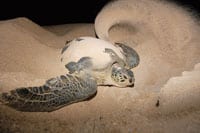Many sea turtle populations are growing due to worldwide conservation efforts.
At a recent meeting of the International Union for the Conservation of Nature (IUCN) Specialist Group Chairs in Abu Dhabi, someone laughed that the Invertebrate Specialist Groups had thousands of species to conserve and few individuals to do it, while the Marine Turtle Specialist Group had only a handful of species but thousands of people worrying about them. Marine turtles have garnered the attention of conservationists, government officials, the public and the media, and they have sparked a conservation frenzy over the last few decades.
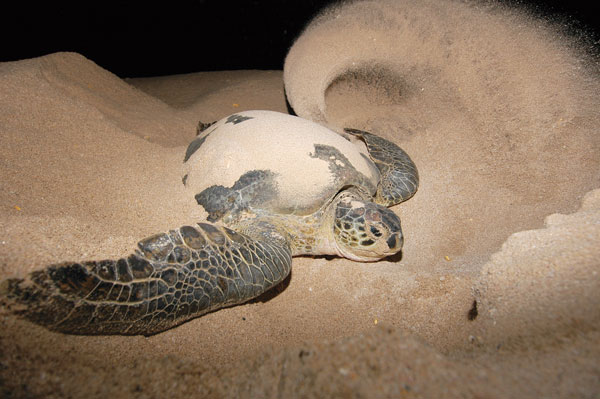
Photo by Nicolas Pilcher, Ph.D
A green sea turtle digs its nest prior to laying eggs at Ras Al-Hadd, Oman
It is hardly surprising sea turtles have a global following, or that they have polarized the research and conservation community. They are valued in various ways by various people: food for some, study material or cute and cuddly conservation attractions for others. Sea turtles are intriguing, and the challenges in understanding their biology because of their dispersed lifestyle at sea are formidable. There is no such thing as “one conservation approach fits all.” In one area a turtle species can be thriving, while across an ocean basin it could be on the verge of collapse.
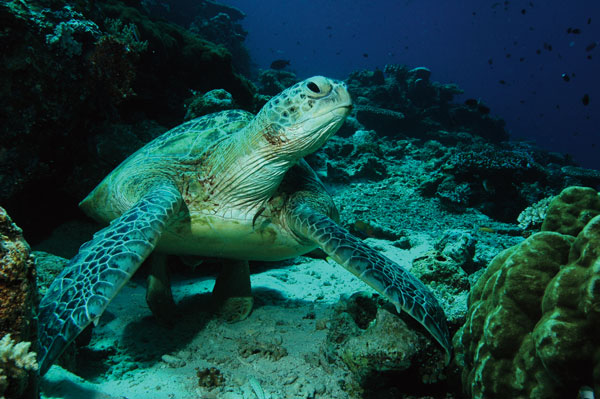
Photo by Nicolas Pilcher, Ph.D
A green sea turtle off the coast of Sipadan Island in Indonesia.
We know a lot about sea turtles, but we are also in the dark. We know loads about how they reproduce, but oddly, we know very little about why some populations rebound with gusto while others languish in the recovery doldrums. Sea turtles are, at the same time, a mystery and an open book.
Sea Turtles' Beleaguered Existence
For thousands of years, sea turtles have been used by mankind as an important food source. They support many economies through tourism, and they aesthetically enhance coastal seascapes. They have been described as marine substrate engineers and nutrient transporters due to their feeding and nesting habits, in which large amounts of egg material are left on beaches to act as fertilizer, and by interactions with marine habitats that ensure ecosystem health. Sea turtles also play valuable ecological roles as consumers and prey, and have been indirectly linked to seabed and fisheries stability. Green sea turtles crop seagrasses and maintain the health of important habitats that are developmental grounds for shrimp and other larvae that are the building blocks of economically valuable industries.
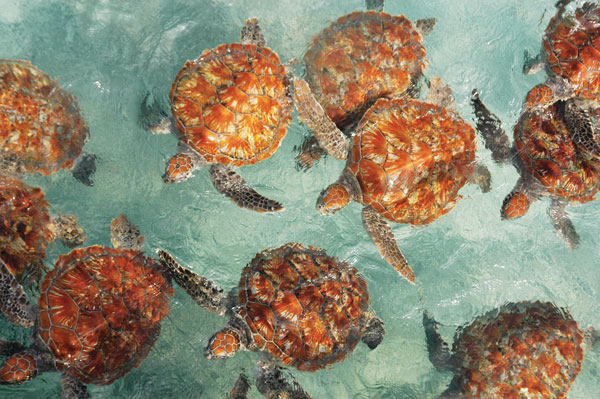
Photo by Nicolas Pilcher, Ph.D
These 1-year-old green sea turtles are in an enclosure on a reef in the Maldives.
Being long-lived and of late maturation, sea turtles face a multitude of threats over long periods of time, including mortality in mechanized and artisanal fisheries, egg and turtle consumption, and habitat degradation and loss. They are evolutionarily prepared to suffer high mortality rates in the early life stages, but large juveniles and adults have substantially high reproductive and population maintenance value. The loss of a small proportion of eggs or hatchlings may be compensated by their demography in the short-term, but the loss of older animals can have substantial negative effects on population size.
Compounding this, turtles comprise distinct genetic stocks that preclude substantial interaction of stocks, restricting gene flow. This means turtle populations that have been decimated will not rebound through immigration from outside populations. When they’re gone, they’re gone.
Additionally, hatchling sea-finding and orientation are guided by visual stimuli: baby turtles orient toward a brighter horizon and away from a darker one. Therefore, altered ambient lighting due to human presence may disorient hatchlings, causing high mortality levels.
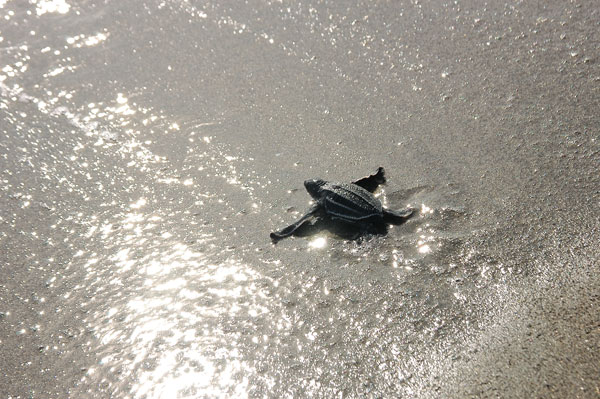
Photo by Nicolas Pilcher, Ph.D
This sea turtle hatchling races to the sea.
Given these biological characteristics and the threats sea turtles face, conservation is a massive challenge. Hatchlings disperse into open-ocean areas, adults migrate great distances between foraging and nesting habitats, and juveniles and adults can occupy multiple foraging grounds at different stages of their life cycle. Imagine figuring all that out in order to save turtles!
Since the “conservation awakening” for sea turtles by Archie Carr in the 1960s and thereafter, and because of Carr’s pioneering work in Costa Rica and in Florida, conservation programs have struggled to meet the varied threats, and costs have grown exponentially. So where does that leave the turtles? Over the years, there have been some hopeful success stories. Let’s take a look at five.
Five Sea Turtle Successes
Costa Rica: In the 1950s, one of the forefathers of the modern-day turtle conservation movement, Dr. Archie Carr, came across a black, sandy beach some 50 miles north of Limón, on the Caribbean coast of Costa Rica, where hundreds of green turtles (Chelonia mydas) had laid their eggs. Sadly, local poachers had long been aware of the location of the site — sea turtles and eggs were a valuable commodity — and the population there was in steep decline. Dr. Carr suggested to the Costa Rican government that all of Tortuguero beach be set aside as a national park and that turtle hunting be banned in the country. His recommendations came to pass in 1975, and the Tortuguero green turtle colony experienced a remarkable recovery. Today, it is by far the largest sea turtle colony in the Western Hemisphere. Foraging-ground mortality still occurs but does not seem to have impacted the steady growth in nesting numbers.
Mexico: Up the coast in Tamaulipas, Mexico, there used to be thousands upon thousands of nesting Kemp’s ridley sea turtles (Lepidochelys kempii), but by the 1960s nesting had declined by about 80 percent with no signs of slowing down. In 1977, armed guards began protecting the key nesting beach from egg poachers, and a concurrent prohibition of fishing in near-shore waters prevented the species from becoming extinct. The U.S. and Mexico worked closely together, and since then, the Kemp’s ridley has staged an amazing comeback.
Cuba: Cuba was once a key player in the hawksbill (Eretmochelys imbricata) shell industry, amassing huge stockpiles of shells over the years, which many scientists attributed to regional hawksbill declines. When Cuba eventually eliminated all legal take of hawksbills, and the species’ main nesting and feeding areas came under special protection, strong population recoveries took place, and Cuban conservation efforts are helping regional nesting aggregations achieve astonishing comebacks. To give you an example, at Mona Island in Puerto Rico, nesting numbers have risen 700 percent in the last 20 years, and continue to rise 10 to 20 percent annually! Hawksbill populations are also on the rise in the Yucatan peninsula and in Barbados.
Malaysia: Across the planet, Malaysian turtle populations in the early 1970s suffered dramatic declines. In peninsular Malaysia, sea turtles had crashed, with reported declines of up to 99 percent. The leatherback (Dermochelys coriacea) population in Terengganu was well on its way to local extirpation, the Sarawak green turtle egg harvest was drying up, and the olive ridley (L. olivacea) was fast disappearing. The turtles in Sabah faced a similar fate, but in the 1960s, the Sabah state government purchased the key nesting islands from the local inhabitants and turned them into a protected area. Today, the Turtle Islands Park boasts the most robust and growing population of turtles in all of Southeast Asia, numbering thousands of nesting females.
Hawaii: In Hawaii, the green turtle was hunted by ancient Hawaiian people, and turtle meat was an important food resource managed through royalty-controlled hunting. Turtle shells and bones were also used for fashioning tools, such as fishing hooks, and as personal ornaments. Later, the turtle was harvested during expeditions to the northwestern Hawaiian Islands, and the pressure persisted at foraging grounds of the main Hawaiian Islands until the mid-1900s. Commercial harvest to support local demand and tourism increased significantly in the 1960s and early 1970s, and there was unregulated traditional harvest by native Hawaiian and other Pacific islander communities. Not surprisingly, by the mid 1970s, the Hawaiian green turtle population was over-exploited and reduced to approximately 20 percent of what it used to be. But the Endangered Species Act (ESA) of 1973 has since turned the declines around, and the number of nesting green turtles in Hawaii has increased dramatically over the past 30 years, with an estimated annual growth rate of 5.7 percent per year. This, and a helping hand from dedicated biologists, has led to the near-complete recovery of the population, with some areas considered to be at carrying capacity, and even to the point where native Hawaiian groups are calling for a reopening of the traditional harvests.
All of these success stories were bold and novel approaches to conservation at the time, they all persisted for at least 20 years, and they all had a charismatic driver (or two or three) behind them: Archie Carr in Costa Rica; Georgita Ruiz and Rene Marquez in Mexico; Felix Moncada and Elvira Carrillo in Cuba; Stanley deSilva in Malaysia; and George Balazs in Hawaii. Sea turtle conservation has been linked to charismatic and influential people across the globe, and as this community has grown, so have the varied approaches to conservation. We are by no means out of the woods yet, but we are well on our way.
Turtle Excluder Devices: Sea Turtle Lifesavers
The development of turtle excluder devices (TEDs) for shrimp trawls and circle hooks for longline fisheries have had a dramatic impact on the recovery of sea turtles at sea. A TED is little more than a metal grid inserted into trawl nets to reduce the accidental take of unwanted bycatch, such as sea turtles. The grid allows the catch to pass through to the cod end of the net (the bag at the back where the shrimp are collected), while large objects, such as debris and turtles, are ejected out of a flap of net material.
Circle hooks are what the name implies: Rather than the “J” shape of traditional hooks, circle hooks are more circular. They are still effective in catching fish, but they don’t injure turtles that may accidentally ingest them when stealing bait from longlines.
Both TEDs and circle hooks have done much to help turtles, but we still have not solved the problem of bycatch in gill nets, possibly the most prevalent fishing method across the globe. Some novel solutions are being tested, including the use of lights, pingers, shark silhouettes and even nets without buoys. While all of these do reduce the turtle catch, they often impact target catches as well, or they are simply not very effective.
The Endangered Species Act, with its specific enforcement penalties, was a critical step in providing legal protection to many species, sea turtles included, and it established the foundation upon which conservationists and government agencies grounded their turtle-related protection activities. Without the ESA, there would likely be no TEDs, no lawsuits to close fisheries in which bycatch is an issue, no nest relocation in the face of natural and anthropogenic threats (such as the Gulf of Mexico oil spill), nor restrictions on sea turtle harvests and trade in sea turtles.
Recently, conservationists have become more adept at working with communities that directly interact with sea turtles, be it for food or accidentally. In many societies across the Pacific, and indeed, many developing countries throughout much of the tropical belt, turtles are an in-demand source of protein. They also play an important role in traditional ceremonies within these communities, such as marriage and coming-of-age celebrations.
Contemporary research and conservation efforts working with communities that have relied upon sea turtles are resulting in sea turtle population recovery at a localized level, with regional and global impacts. In Baja California, Mexico, the local Groupo Tortuguro (Turtle Group) has adopted a self-imposed no-fishing area, and voluntarily adopted gear changes from bottom longlines to more turtle-friendly hook-and-line fishing. Their efforts are being felt across the ocean in Japan, where increasing numbers of adult loggerheads (Caretta caretta) now nest.
In Papua New Guinea, locals have voluntarily abandoned the harvesting of critically endangered leatherback turtle eggs in favor of village development and tourism. Their commitment reverberates across the Pacific, where the leatherback has been in precipitous decline, but numbers appear to be steady.
In the Philippines, local Barangay communities have established their own community-based coastal protected areas to preserve marine resources, including sea turtles. Their efforts can be seen across Southeast Asia, where populations of green and hawksbill turtles are slowly recovering.
The list seems endless, and it continues to grow.
How to Save Sea Turtles
The continued exploration and development of conservation solutions will result in sea turtle population recovery so long as this is done in a timely manner and we do not revert to the same actions that resulted in their population declines in the first place. The abundance and diversity of people involved in the development of solutions and the implementation of conservation programs around the world is what underpins all past successes and future hopes of sea turtle conservation. It is the problem-solving, challenge-loving, technology-linked, people-friendly, turtle-hugging people across the planet who have made a difference, and who are the key to solving conservation challenges. It takes a special class of people to get involved, and I am honored to work alongside them.
Dr. Nicolas Pilcher, Ph.D., is the founder and executive director of the Marine Research Foundation (mrf-asia.org), a non-profit agency in Malaysia that carries out conservation and research projects in the Indo-Pacific region. His Ph.D. is in Marine Turtle Conservation, and he has spent the last 20 years involved in marine conservation. Dr. Pilcher is the co-chair of the IUCN Marine Turtle Specialist Group and a member of the IUCN SSC Marine Conservation Sub Committee.

